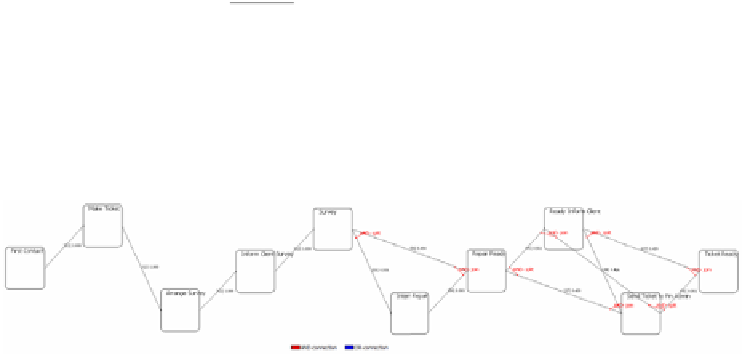Information Technology Reference
In-Depth Information
As the final operation, type of connections at successor and predecessor activity list of
each activity are derived with respect to the AND threshold (
ANDthreshold=0.10
).
Hence dependency/frequency graph is converted into control flow graph as shown in
Figure 3. Sample connection score calculations are as follows;
158
sur
⇒
intRep
∧
repRdy
=
=
0
505
,
then
AND
−
split
type
connection
SPLIT
158
+
154
137
+
175
repRdy
⇒
senTic
∧
rdyInfCli
=
=
1
then
AND
−
split
type
connection
SPLIT
137
+
175
137
rdyInfCli
⇒
repRdy
∧
senTic
=
=
0
.
438
,
then
AND
−
join
type
connection
JOIN
137
+
175
137
senTic
⇒
rdyInfCli
∧
ticRdy
=
=
0
438
,
then
AND
−
split
type
connection
SPLIT
137
+
175
Fig. 3.
Derived Connections in Control Flow Graph.
For this data set, the percentage of transitions in testing dataset that are represented in
the dependency/frequency graph (i.e. recall) is 99.85%. Additionally, all extracted
relations have corresponding complements in testing dataset (i.e. precision of the
discovered process model is 100%) and a 58.87% improvement is achieved in
processing time by the use of GA based rearrangement.
4 Related Work
In
[5]
, Aalst et al. highlights the process mining usage in analysis and improvement of
process flexibility. It proposes the enrichment of obtained event logs with semantic
information. Likewise
[5]
,
[6]
aims to handle both case and control-flow perspectives
in an integrated fashion. While production workflow is strongly process-oriented, the
case handling paradigm basically concentrates on the case itself, which is the
fundamental object to be produced.
The idea of applying process mining in the context of workflow management was
first introduced in
[7]
. In this study, two issues are handled. The first issue is to
discover a workflow graph generating activities appearing in a given workflow log.
The second issue is to find the definitions of the relation conditions.
Cook and Wolf have investigated similar issues in the context of software
engineering process. In
[8]
, they describe three methodologies for process discovery
ranging from the purely algorithmic to purely statistical: RNET, KTAIL and
MARKOV.



Search WWH ::

Custom Search